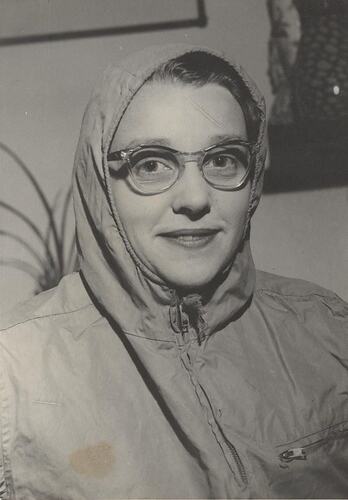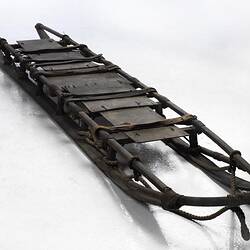Summary
Black and white image of Hope Macpherson at the time of her first expedition to the Antarctic in December 1959. One of the first four women to travel to the Antarctic, Hope was also the first female curator at National Museum of Victoria (now Museum Victoria).
Description of Content
Black and white close up image (head and shoulders) of Hope Macpherson wearing glasses and a weatherproof jacket with the attached hood over her head.
Physical Description
Black and white image.
Significance
The Hope (Macpherson) Black Collection is a significant addition to Museum Victoria's working lives collection, it reveals the journey of a woman from depression era Melbourne and illustrates the power of education. It also reveals the often discriminatory policies in place in Victoria before the equal opportunity developments of the late 20th century. In balance though it also exposes the somewhat free expression possible for empowered women in this period. Hope Macpherson clearly states that in her day to day work she never felt discrimination and believes she was given great opportunity to pursue her career and aspirations. However, on analysis her role was often shaped by her gender and its perceived strengths and weaknesses; she was dissuaded from applying to become a taxidermist as it was 'an unsuitable job for a woman', although part of the first group of female scientists allowed to travel to Macquarie Island they were not permitted to camp on land with the male crew for fear of inciting passions. And finally after a distinguished career she was forced to resign her tenure as Australia's first female Curator when she married late in life, as a consequence of the Marriage bar.
More Information
-
Collection Names
Museum History Collection, Antarctica Collection, Hope Macpherson Black Collection
-
Collecting Areas
-
Acquisition Information
Donation from Hope Black (nee Macpherson), Apr 2011
-
Person Depicted
Miss Hope Macpherson - National Museum of Victoria, Melbourne, Victoria, Australia, Dec 1960
-
Format
Photograph, Black & White
-
Inscriptions
Hope Macpherson, Thala Dann, Dec 1959/60, Sun Tues Nov 15 1960 (hand written in black ink). Copyright Not for Reproduction Herald Photograph supplied Feature Service The Herald & Weekly Times Ltd Melbourne Australia (stamp in black ink). _
-
Classification
-
Category
-
Discipline
-
Type of item
-
Image Dimensions - Photograph
150 mm (Length), 110 mm (Width)
-
Keywords
Education, Museum History, Making History - Macquarie Island Expedition




